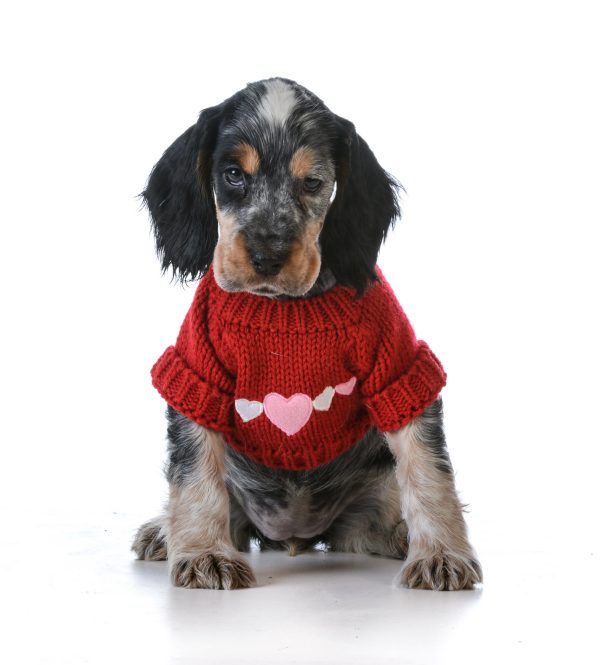
When it’s right, it’s pleasing.

A poorly knit sweater, like the one at the top left, is a visual riot of eye sores. One’s eye jumps between dropped purl stitches and extra rows to loops that didn’t get pulled through. A well crafted sweater, however (as seen at the top right) is harmonious. No one part sticks out because all parts flow into each other.
“Poorly knit” isn’t a term one will come across in any AKC breed standard, but “well knit,” “tightly knit,” or “closely knit,” are. In fact, eight Herding breeds, three Non-Sporting breeds, six Sporting, four Terrier, five Toy, two Working, and six Miscellaneous breeds include one of the aforementioned phrases. A whopping twenty-two FSS breeds include the term while curiously, no Hound breed does. Often, the term describes feet (the Swedish Vallhund standard, for example, calls for toes that are “tightly knit). Sometimes, the term refers to the overall body: From the Portuguese Water Dog standard: “A ruggedly built, well-knit body.” And sometimes, “knit” applies to a particular aspect of the dog. The Chow Chow standard reads, “Stifle Joint shows little angulation, is well knit and stable.”
Helpfully, the Illustrated Standards of some breeds give us more to work with than is mentioned in its standard. The AKC breed standard for the English Cocker Spaniel, for example, writes, “Body-Compact and well-knit, giving the impression of strength without heaviness.”
The English Cocker Spaniel’s Study Guide, however, “fleshes” this out a bit more by explaining (and we’ve bold-faced what we think are the salient words): “Judges should note that while looking at the breed on the line, your eye should not be drawn to any one specific feature. This is a well-knit, one-piece dog, balanced and moderate throughout and free from exaggeration of any kind. He is rounded all over, nether angular nor narrow in any part.”
It’s possible that the word “blend” could substitute the term, “well knit,” but while the former describes a fluidity from one part of the dog to another, the latter implies a tightness, as well. But wait, there’s more! Frank Jackson’s Dictionary of Canine Terms defines “well knit” as: “(of body) powerful and strongly muscled. Few of us would consider the Maltese a “powerful and strongly muscled dog,” and yet “elbows well knit” appear in the breed standard. Consider that in the book, “Canine Lexicon” by Andrew De Prisco and James B. Johnson, “well knit” is explained as “body parts firmly enjoined by well-developed musculature. Often synonymous with short or well coupled, which would indicate a strong loin section joining the chest and hindquarters.”
In their book, Encyclopedia of K-9 Terminology, Edward M. Gilbert Jr. and Patricia H. Gilbert do their readers a favor by having two entries that include the word, “knit:” “Well knit shoulders” (“Well laid in shoulders. Tight placement of the shoulders at the withers. Shoulders that are firmly and smoothly attached or tightly placed at the withers”) and “Well knit pastern joints” (“Well knit pastern joints are strong pastern joints that are joined together securely. The Maltese’s pastern joints are well knit and devoid of appreciable bend”).
We note that various general dictionaries – those not specific to dogs – define “well knit” as meaning “well constructed,” “tightly assembled,” or “closely joined together,” and certainly those interpretations underscore the meaning implied in the English Cocker Spaniel’s Study Guide.
Might one suppose that even in the niche world of dogs, it may come down to semantics?
Image: English Cocker Spaniel puppy by Willee Cole/Adobe Stock Photo
